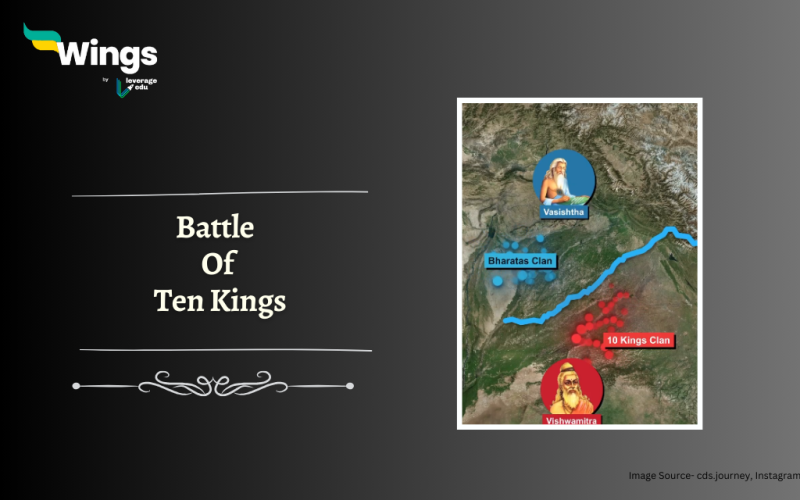The Battle of Ten Kings is also known as the Dasarajana Yuddha. The battle took place between two powerful groups of kings, led by King Sudas of the Bharata tribe and King Vishwamitra of the Trtsu tribe. This battle was first mentioned in detail in the Rigveda, one of the oldest texts in the world. The battle can also be called the First Battle in Indian History. Let us know more about the battle along with its background and outcome.
| Battle of Ten Kings Overview | |
| First Mentioned In | Rigveda (1500-1000 BCE) |
| Place | Near River Ravi in Punjab |
| Fought Between | King Sudas Vs King Vishwamitra |
| Tribes | Bharata tribe & Trtsu tribe |
| Won By | King Sudas |

Background Of The Battle
The Story of the Battle of Ten Kings was first recorded in the history of the subcontinent of India in the Early Rig Vedic period in 1500-1000 BCE. As per the Rigveda (Book 7 or 7th Mandal), the Dasarajana yuddha, was fought on the banks of the river Ravi, which is referred to as Paurushni in Sanskrit.
- The Rig Vedic society was a tribal society that worshipped natural forces like wind, fire, thunder, etc. and followed polytheism.
- The society was patriarchal, but women held important positions and attended important assemblies. The society was also advanced in military techniques, with horse-drawn chariots, coats of mail, swords, and arrows.
- The Battle of Ten Kings was fought between the Bharata tribe and a confederacy of tribes like – Anus, Yadus, Alina, Pakthas, Turvasa, Shimyu, Shivas, Druhyus, Bhalana, Purus and Vishanin
- Here, the Purus, Yadus, Turvasa, Druhyus and Anus are from Aryan Tribe, and Vishanin, Alinas, Pakthas, Bhalans and Shivas are from non-Aryan tribes.
- During the Rig-Veda era, the Purus were a significant tribe that had close connections with the Tritsus and the Bharatas. They resided on both sides of the Saraswati River.
- The Anus, Druhyus, Yadus, and Turvasas were the Purus’ allies in their fight against the Bharatas. These five groups were known as the Panchjanah in the Rig-Veda.
- The names Yadu and Turvasa were frequently mentioned together in the Rig-Veda.
- The cause of the battle is ambiguous, but historians suggest two main reasons – the expansionist policy of King Sudas and the removal of a famous priest. The decisive battle took place at the river Ravi.
- While, the other cause is said to have been a long-standing feud between the Bharata and Trtsu tribes over land and cattle.
Also Read – Gurukul Education System in Ancient India
Event Of The Battle
The Battle of Ten Kings was a fierce and bloody conflict that lasted for several days. The two sides clashed on the banks of the river Ravi, also known as Parushni, with both armies displaying great valour and skill in combat. King Sudas, though outnumbered led his army with courage and determination, inspiring his soldiers to fight fiercely against their enemies.
The battle was marked by intense fighting, with both sides sustaining heavy casualties. King Sudas and his allies employed strategic manoeuvres and clever tactics to gain the upper hand in the battle. Despite facing overwhelming odds, they managed to outwit and defeat the coalition of ten kings.
Outcome Of The Battle
In the end, King Sudas emerged victorious in the Battle of Ten Kings. His enemies were defeated, and their forces were scattered and demoralized. The Bharata tribe solidified its dominance in the region, while the defeated kings were forced to acknowledge King Sudas’s authority.
- The victory in the Battle of Ten Kings cemented King Sudas’s reputation as a powerful and skilled warrior.
- It also established the Bharata tribe as a force to be reckoned with in the ancient Indian subcontinent.
- The Purus tribe lost their king, and the Bharatas moved eastward and formed the Kuru tribe, which we know from the story of Mahabharata.
Relevant Blogs
This was all about the Battle of Ten Kings or Dasarajana Yuddha. For more content related to the different states of India, visit our articles like this, you can get Study notes on the Modern History of India here. Also, you can visit our general knowledge page on Indian History!
 One app for all your study abroad needs
One app for all your study abroad needs













